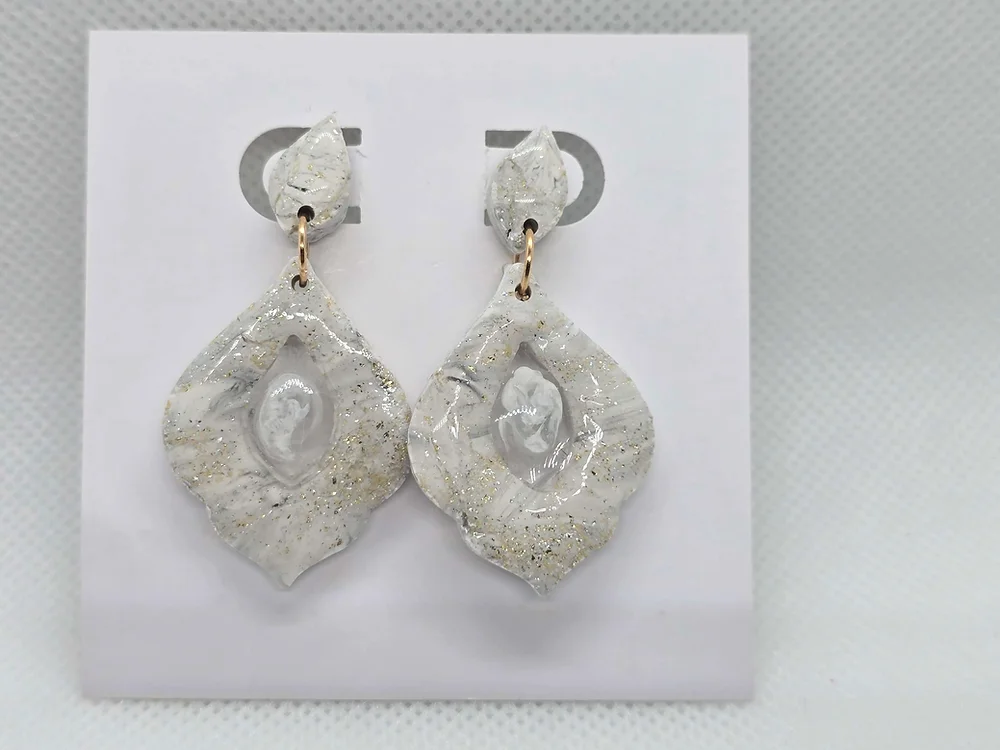Can Polymer Clay Earrings get wet?
- Leah Milsom
- Feb 19
- 3 min read
Updated: Apr 10
By Lelalo

Polymer clay is a popular material for making handmade jewellery, including earrings, because of its flexibility, durability, and vibrant colour options. However, many jewellery makers and wearers wonder: Can polymer clay earrings get wet? The short answer is yes but with limitations. While polymer clay itself is water-resistant after baking, prolonged exposure to water, moisture, or harsh conditions can affect its appearance and longevity. Let’s dive into the details.
Understanding Polymer Clay’s Water Resistance
Polymer clay is a plastic-based modelling material that hardens when baked in an oven. Unlike air-dry clay or ceramic, polymer clay does not absorb water after it is properly cured. This means that occasional contact with water, such as rain or handwashing, will not immediately damage polymer clay earrings.
However, just because polymer clay is water-resistant does not mean it is entirely waterproof. Certain factors, such as the quality of the clay, the baking process, and additional finishes like paints or sealants, can determine how well the earrings hold up when exposed to moisture.
Situations Where Polymer Clay Earrings Might Get Wet
1. Light Water Exposure (Safe)
Polymer clay earrings can generally handle brief contact with water, such as:
Getting caught in the rain
Accidental splashes while washing hands
Humidity in the air
As long as the earrings are properly cured and sealed, occasional water exposure will not harm them.
2. Prolonged Water Exposure (Risky)
While polymer clay itself is not water-soluble, long-term exposure to water or submersion can cause issues. Situations to avoid include:
Wearing polymer clay earrings in the shower
Swimming while wearing them
Submerging them in water for extended periods
Continuous water exposure can weaken some sealants, adhesives, or decorative elements like paint, potentially leading to peeling, fading, or damage to metal components.
3. Hot Water Exposure (Risky)
Hot water can be more problematic than cold water because it may soften polymer clay slightly, especially if the earrings were not baked at the correct temperature. Additionally, hot water can break down glue bonds, causing embellishments, posts, or other elements to detach over time.

How to Protect Polymer Clay Earrings from Water Damage
To ensure your polymer clay earrings remain in excellent condition, follow these protective measures:
1. Seal Your Earrings
While polymer clay does not need sealing, a sealant can provide an extra layer of protection, especially if you’ve painted or decorated your earrings. The best sealants for water resistance include:
Water-based polyurethane varnish – A strong, protective coating with either a matte or glossy finish.
Resin coating – Provides a thick, glossy, and waterproof layer, making earrings extra durable.
Acrylic spray sealants – Can help protect against moisture but should be applied in light layers.
Avoid using nail polish as a sealant, as it can cause polymer clay to become sticky over time.
2. Store Your Earrings Properly
When not in use, keep your polymer clay earrings in a dry, cool place away from excessive humidity. A jewellery box or an airtight container works well to prevent exposure to moisture in the air.
3. Avoid Prolonged Water Exposure
To extend the life of your polymer clay earrings:
Remove them before swimming, showering, or washing dishes.
Dry them immediately if they get wet to prevent damage to metal parts or decorative finishes.
4. Use Waterproof Adhesives for Attachments
Many polymer clay earrings have metal posts or hooks attached with glue. If water weakens the adhesive, these attachments might come loose. Using industrial-strength adhesives like E6000 or UV resin can help ensure long-lasting adhesion.
What to Do If Your Polymer Clay Earrings Get Wet
If your polymer clay earrings accidentally get wet, don’t panic. Here’s how to handle it:
Dry them immediately with a soft cloth to remove excess moisture.
Check for damage to the paint, sealant, or glued attachments. If the sealant appears cloudy or the glue weakens, consider reapplying a protective coat.
Allow them to air dry completely before storing or wearing them again.
Final Thoughts
Polymer clay earrings can withstand light water exposure, but prolonged contact with water, especially hot water, should be avoided to maintain their quality and durability. While polymer clay itself is water-resistant, elements like paint, glue, and metal findings may be affected by moisture.
By taking simple precautions—such as sealing your earrings, storing them properly, and avoiding prolonged submersion—you can keep your polymer clay earrings looking beautiful for years to come. So, while a little rain won’t hurt, it’s best to keep your earrings dry to preserve their charm and longevity.
Comentarios